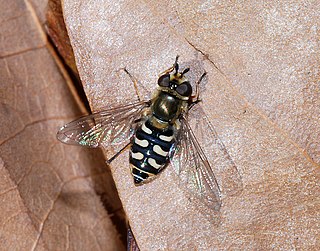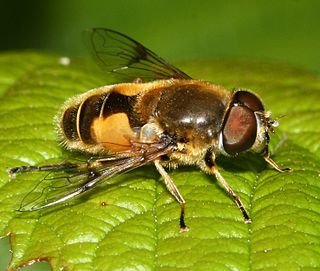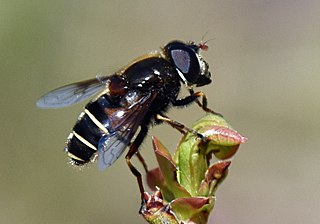
Hover flies, also called flower flies or syrphid flies, make up the insect family Syrphidae. As their common name suggests, they are often seen hovering or nectaring at flowers; the adults of many species feed mainly on nectar and pollen, while the larvae (maggots) eat a wide range of foods. In some species, the larvae are saprotrophs, eating decaying plant and animal matter in the soil or in ponds and streams. In other species, the larvae are insectivores and prey on aphids, thrips, and other plant-sucking insects.

Bill Gates' flower fly is a flower fly endemic to Costa Rica named after Bill Gates. Another fly found in similar habitats was named after Gates' associate Paul Allen, called Paul Allen's flower fly ; according to Chris Thompson, the describer of these species, both names were in "recognition of [their] great contributions to the science of Dipterology".
Paul Allen's flower fly is a flower fly found only in Costa Rican forests in the central highlands. It was named after Paul Allen. Another fly was also named after Allen's associate Bill Gates, Bill Gates' flower fly.

Eristalis is a large genus of hoverflies, family Syrphidae, in the order Diptera. Several species are known as drone flies because they bear a resemblance to honeybee drones.

The Syrphoidea are a superfamily of flies containing only two families under present classification, one of which (Syrphidae) has a great number of the most common and familiar flies. One of these familiar flies is Eristalis tenax, or otherwise known as the drone fly.

Eristalis tenax, the common drone fly, is a common, migratory, cosmopolitan species of hover fly. It is the most widely distributed syrphid species in the world, and is known from all regions except the Antarctic. It has been introduced into North America and is widely established. It can be found in gardens and fields in Europe and Australia. It has also been found in the Himalayas.

Rat-tailed maggots are the larvae of certain species of hoverflies belonging to the tribes Eristalini and Sericomyiini. A characteristic feature of rat-tailed maggots is a tube-like, telescoping breathing siphon located at its posterior end. This acts like a snorkel, allowing the larva to breathe air while submerged. The siphon is usually about as long as the maggot's body, but can be extended as long as 150 mm (5.9 in). This organ gives the larva its common name.

Eristalis arbustorum, the European drone fly, is an abundant Northern Hemisphere species of syrphid fly, originally officially described by Linnaeus in 1758 as Musca arbustorum. The name "drone fly" is related to its similar appearance to the drone of the honeybee. Hoverflies get their names from the ability to remain nearly motionless while in flight. The adults are also known as flower flies as they are commonly found on and around flowers from which they get both energy-giving nectar and protein rich pollen. The larvae are aquatic filter-feeders of the long-tailed type.

Eristalis horticola is a Palearctic species of hoverfly.

Eristalis cryptarum is a holarctic species of hoverfly. Known as the bog hoverfly or bog-dwelling drone fly, it is a bog specialist but may occur in other wetlands. Its larvae are assumed to live in peat that is saturated with water, such as that found in these boggy areas. The female has been observed depositing eggs on and close to very fresh cow dung along oligotrophic seepages in moorland.

Eristalini is a tribe of hoverflies. Several species are well-known honeybee mimics, such as the drone fly Eristalis tenax, while other genera such as Helophilus and Parhelophilus exhibit wasp-like patterns of yellow and black stripes, both strategies to avoid predation by visual predators such as birds.
Eristalis oestracea, the orange-tailed drone fly, is a species of hoverfly native to Europe and North America. In Europe it is found in bogs, moors, and coastal dunes. It nectars on white flowers in the carrot family (Apiaceae) and yellow flowers in the aster family (Asteraceae). It is very poorly known in North America. E. oestracea measures 14-15 mm in length.

Eristalis flavipes, the orange-legged drone fly, is a species of hoverfly native to North America. It flies from early April to mid-October, and occurs in a wide variety of habitats, particularly wetlands. Hoverflies get their names from the ability to remain nearly motionless while in flight. The adults are also known as flower flies for they are commonly found around and on flowers, from which they get both energy-giving nectar and protein-rich pollen. The larvae are aquatic filter-feeders of the rat-tailed type.

Eristalis anthophorina, the orange-spotted drone fly, is a species of syrphid fly with a Holarctic distribution. It is a common fly in wetlands, including bogs, fens, and woodland pools. In North America, it occurs throughout much of Canada and primarily in the northern parts of the United States. It may be introduced in North America.

Eristalis bellardii, the Mexican mountain drone fly, is an uncommon species of syrphid fly first officially described by Jaennicke in 1867. It is infrequently found in the Southwestern United States, Mexico and Central America. In appearance it is somewhat like that of a honeybee. Hoverflies get their names from the ability to remain nearly motionless while in flight. The adults are also known as flower flies for they are commonly found around and on flowers, from which they get both energy-giving nectar and protein-rich pollen.

Eristalis dimidiata, the black-shouldered drone fly, is a species of hoverfly native to much of Canada and the eastern and northern United States. It flies year-round in southern areas and from late March to mid-November further north. It is one of the earliest hoverflies to fly in the spring, and as such likely overwinters as an adult. It lives primarily in forests.

Eristalis stipator, the yellow-shouldered drone fly, is a species of hoverfly native to North America. It is abundant in western North America, with a few scattered records in the east. It flies from mid-May to early November, and is known to hilltop.

'Eristalis saxorum, the Blue-polished Drone Fly, is an uncommon species of syrphid fly found along the Eastern United States. Hoverflies get their names from the ability to remain nearly motionless while in flight. The adults are also known as flower flies for they are commonly found around and on flowers, from which they get both energy-giving nectar and protein-rich pollen. The larvae are aquatic filter-feeders of the rat-tailed type. The larvae of this species have not been identified. Little is known about this uncommon species which flies from mid-March to late October.

Eristalis obscura, the dusky drone fly, is a common species of syrphid fly first officially described by Loew in 1866. This species is widespread in the northern part of North America and Europe east to Siberia. Hoverflies get their names from the ability to remain nearly motionless while in flight. The adults are also known as flower flies for they are commonly found around and on flowers from which they get both energy-giving nectar and protein-rich pollen. The larvae are aquatic filter-feeders of the rat-tailed type.
















